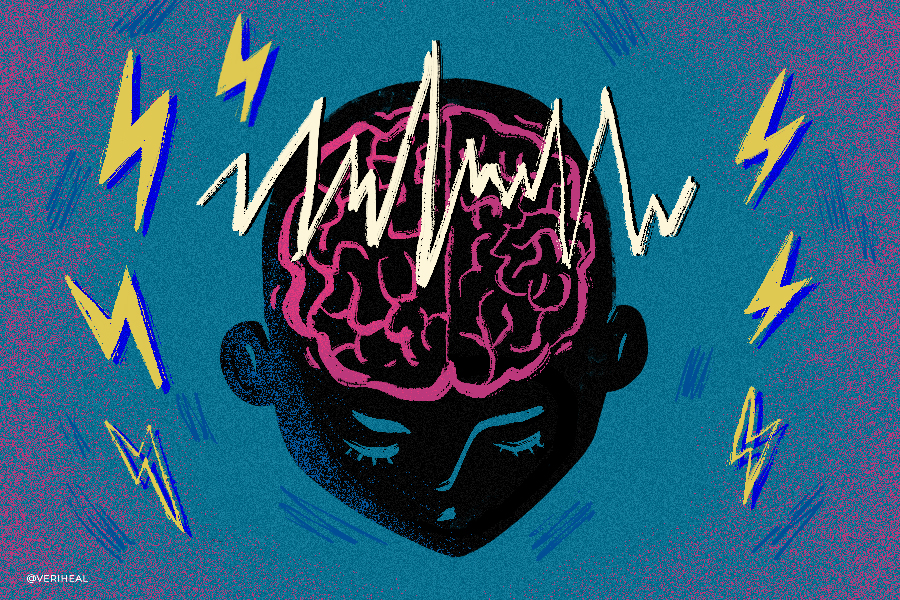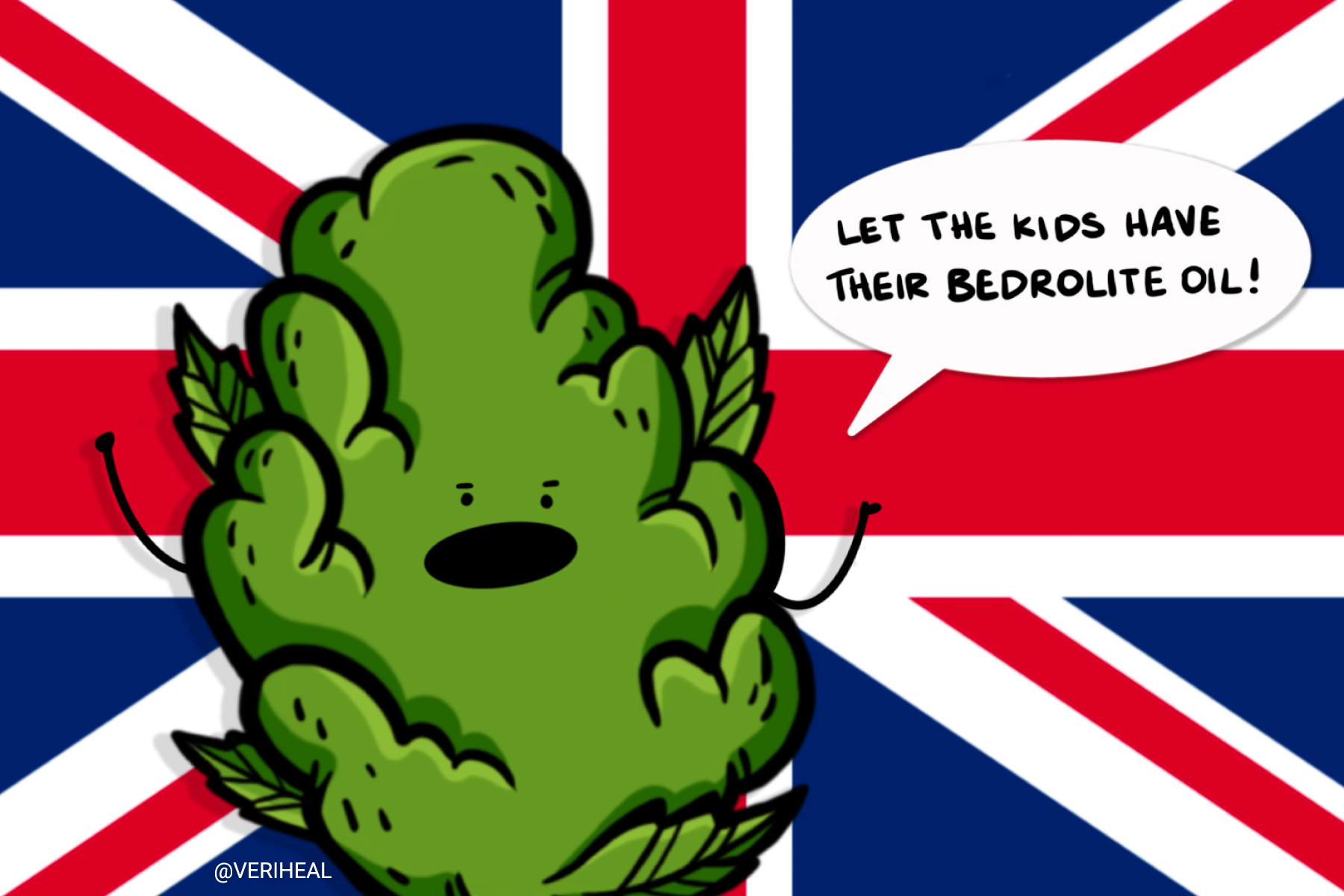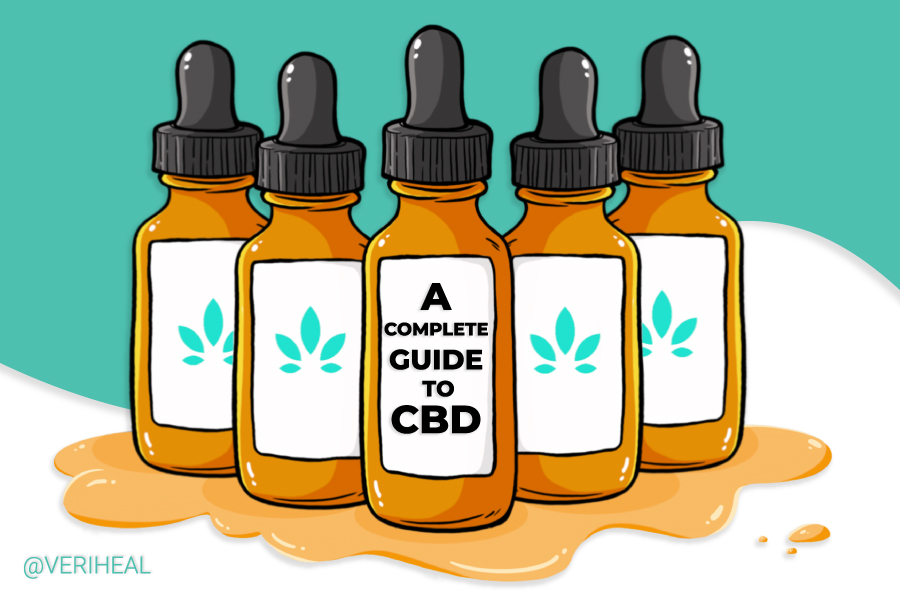Medical Cannabis Options for Patients Living with Epilepsy

- Epilepsy and Medical Cannabis: Considerations to Keep in Mind
- Why Use Cannabis to Help With Epilepsy Symptoms?
- Cannabis-based Prescription Medications
- Understanding the Different Types of Epilepsy
- A Patient’s Perspective on Using Cannabinoids for Epilepsy
Endocannabinoids are natural cannabinoids that are made by the body and are essential for the functionality of the brain and spinal cord, which are the major components of the central nervous system. These self-produced endocannabinoids normally decrease the release of neurotransmitters that activate neurons, and therefore, decrease seizures (18). This endocannabinoid system that the body already uses to control seizures can also be driven by cannabidiol (CBD) and Δ9-tetrahydrocannabinol (THC), two major chemical components of the cannabis plant that interact with the endocannabinoid receptors of the body.
For more information on how the endocannabinoid system works, please see our page on endocannabinoids here. Read on to learn more about epilepsy and why medical cannabis is being used to treat some epileptic patients.
Epilepsy and Medical Cannabis Considerations to Keep in Mind
According to an informational handout on medical marijuana from the Epilepsy Foundation, CBD and cannabis use must be discussed with your doctor, because the combinations of medicines taken are tailored to each patient based on the type of epilepsy and other factors (12). When a doctor is not consulted, you put yourself at a greater risk for breakthrough seizures, medication side effects, or other serious complications.
If you take any of the following medications or have any of the following issues, please consult your prescribing doctor (12):
- Any seizure or neurological disorder
- Elevated liver enzymes
- Valproic Acid
- Clobazam
- Phenytoin
- Lamotrigine
- Topiramate
- Rufinamide
- Eslicarbazepine
- Zonisamide
- Carbamazepine or oxcarbazepine
- Ethosuximide
- Phenobarbital
The most common delivery routes for CBD and THC are via smoking or vaporizing cannabis extracts, edibles, dabbing or CBD-only products (16). When smoked or vaped, it is effectively distributed by the lungs, because it is rapidly distributed in the brain and organs without “first-pass” degradation by the liver. However, inhalational methods may not be appropriate for everyone, especially children. It can also have other drawbacks and health risks.
Because CBD has more promising antiepileptic properties, extra attention should be paid to options that contain a higher ratio of CBD to THC (11). This is represented on packaging with ratios such as 2:1, 3:1, 20:1, etc.
Based on animal data, edible CBD is approximately 13-19% bioavailable (13), which means that oral, nasal and sublingual (under the tongue) routes are less efficient consumption methods for the condition, because it is difficult for the full dose to take effect without more bioavailability (16). New research data shows the bioavailability of edible CBD can be increased if taken with food (13).
Why Use Cannabis to Help with Epilepsy Symptoms?
Patients using medicinal cannabis have the potential for CBD-rich products to help decrease seizure frequency, which depends on the type of seizures they experience (4) (19). In addition, patients using cannabis products may experience relief from adverse effects of medication and comorbid conditions such as (17):
- Chronic Pain
- Sleep issues
- Anxiety
- Depression
- Dystonia, or spasticity
Patients who want to use CBD only can see the following benefits (1):
- Reduction in inflammation
- Anxiety
- Pain relief
- Neuroprotective properties
Patients in double-blind clinical trials testing CBD and THC have experienced the following adverse effects to watch out for (19):
- Somnolence or sleepiness
- Appetite changes
- Diarrhea
- Fatigue
- Convulsions
- Increased seizures
According to the Epilepsy Foundation and the US Food and Drug Administration (FDA), you need to take extra care using cannabis if you currently have elevated liver enzymes levels that are three times the normal levels or higher, because it is metabolized in the liver (7) (14). However, liver enzymes tended to normalize even with continued or reduced CBD dosing in the trials (7).
Cannabis-based Prescription Medications
As of October 2020, Epidiolex is the only cannabis-derived prescription medication available on the market in the United States (5). It is made with derivatives from pure cannabidiol and can be used in anyone over the age of two. The medication is meant to help patients with Dravet syndrome and Lennox-Gastaut syndrome (LGS), both rarer forms of epilepsy that often have seizures that are not controlled by other prescription anti-seizure medications.
The vast majority of quality research studies regarding epilepsy and cannabis are focused on Epidiolex, which has laid strong groundwork for cannabis treatment in states where medical marijuana cards are available for the condition (1) (7). In a research study funded by the Epilepsy Project in 2016, they found that the medication has very promising potential to help reduce the amount of seizures in child onset, treatment-resistant epilepsy (3).
The trial participants were already taking antiepileptic drugs before the trial began. The patients ranging from one to 30-years-old were given doses beginning with 2 to 5 mg of CBD a day; that was titrated up to a maximum dose of 25 to 50 mg daily. At 12 weeks of treatment, the patients experienced a 36.5% reduction of seizures (3).
The most common Epidiolex side effects include (7):
- Somnolence
- Decreased appetite
- Diarrhea
- Liver transaminase elevations, including alanine transaminase (ALT) and aspartate aminotransferase (AST)
Like using cannabis, this medication is not for everyone. It can have drug interactions in patients who are taking concomitant valproate and/or clobazam (7). It is extremely important to talk with the doctor before beginning treatment of epilepsy for lab work, follow-up, and proper dosing.
Understanding the Different Types of Epilepsy
Considering that 65 million people around the world have the diagnosis, six out of ten cases are still from unknown causes. In addition, one out of three people with the condition do not get symptomatic relief from available prescription medications (18).
Epilepsy is typically characterized and diagnosed after a person experiences two or more seizures that are not linked directly to a head injury or known cause. Although seizures originate and occur in the brain, we know that other organs can be damaged or injured from seizures. We also know that there is not a one diagnosis fits-all and the condition is graded on a scale much like Autism Spectrum Disorders (18). Diagnosis requires specialized testing by a neurologist.
The first variance in the condition is the type of seizures people have. This is an important factor for patients to understand when they go to receive treatment, because different types of seizures are treated with different medications (15). This includes the medical use of cannabis and cannabidiol, because some seizures may not respond to standard medications (called “drug-resistant” or “refractory”) and may worsen depending on the seizure type. The three major groups of seizures are (10):
- Generalized Onset: These seizures can affect both sides of the brain at the same and they are the largest group of seizure types.
- Focal Onset: Focal onset, otherwise known as partial onset, are seizures that start in one area of the brain and only happen on one side of the brain.
- Unknown Onset: Unknown onset seizures are exactly that; it is unknown where the seizure begins. If a patient has a seizure at night, or while no one has witnessed it, it can be initially considered an unknown onset, but may later be diagnosed as general or focal onset.
Defining the types of seizures helps doctors determine the type of epilepsy that someone has and what kinds of treatment options they can pursue, including medicinal marijuana and CBD. Some types of the disorder include (8):
- Autosomal Dominant Nocturnal Frontal Lobe Epilepsy (ADNFLE)
- Childhood Absence Epilepsy
- Benign Rolandic Epilepsy
- Doose Syndrome
- Dravet Syndrome*
- Early Myoclonic Encephalopathy (EME)
- Jeavons Syndrome
- Landau-Kleffner Syndrome
- Lennox-Gastaut Syndrome (LGS)*
- Temporal Lobe Epilepsy
* Dravet Syndrome and LGS are rarer forms of childhood epilepsy that can be treated with Epidiolex, a CBD-derived prescription medication (6).
A Patient’s Perspective on Using Cannabinoids for Epilepsy
For Jamie Ziraldo, a mother of a 5-year-old who experiences intractable partial symptomatic epilepsy with complex focal seizures, being able to get a medical marijuana card for her son has been life-changing. Currently, Ziraldo’s son takes a total of five antiepileptic medications as well as CBD and THC to get relief from his seizures.
“We give him CBD and THC tinctures at night after his medication to lessen the possibility of him experiencing the high. We give it two hours after his nighttime seizure medications to make sure his body can completely metabolize both the pharmaceuticals and the oil. We have seen a decrease in seizures. It went from three to seven a day to one every three to four weeks after starting this regimen,” said Ziraldo.
Ziraldo prefers to give her son the THC at night in order to reduce the intoxicating effects of the cannabis, while allowing her son to sleep through the night. (Unlike THC, CBD is not intoxicating.) She said he is currently waiting to undergo surgery to implant a Vagus Nerve Stimulation (VNS) device to help control the seizures. The CBD and THC gives her son relief until he can get the surgery done (9).
“The stigma about medical marijuana desperately needs to be erased. For my child with epilepsy, medical marijuana means a huge decrease in seizures and a huge increase in quality of life,” said Ziraldo.
Note: Veriheal does not intend to give this as professional medical advice. Do not attempt to self-diagnose, or prescribe treatment based on the information provided on this page. Always consult a physician before making any decision on the treatment of a medical condition.
1. CANNABIDIOL (CBD) Critical Review Report- World Health Organization. (2018, June 4). Retrieved from https://www.who.int/medicines/access/controlled-substances/CannabidiolCriticalReview.pdf.
2. Devinsky, O., Cilio, M. R., Cross, H., Fernandez-Ruiz, J., French, J., Hill, C., Katz, R., Di Marzo, V., Jutras-Aswad, D., Notcutt, W. G., Martinez-Orgado, J., Robson, P. J., Rohrback, B. G., Thiele, E., Whalley, B., & Friedman, D. (2014). Cannabidiol: pharmacology and potential therapeutic role in epilepsy and other neuropsychiatric disorders. Epilepsia, 55(6), 791–802. https://pubmed.ncbi.nlm.nih.gov/24854329/.
3. Devinsky, O., Marsh, E., Friedman, D., Thiele, E., Laux, L., Sullivan, J., . . . Cilio, M. R. (2016). Cannabidiol in patients with treatment-resistant epilepsy: An open-label interventional trial. The Lancet Neurology, 15(3), 270-278. https://pubmed.ncbi.nlm.nih.gov/26724101/.
4. Elliott, J., DeJean, D., Clifford, T., Coyle, D., Potter, B. K., Skidmore, B., . . . Wells, G. A. (2020). Cannabis-based products for pediatric epilepsy: An updated systematic review. Seizure, 75, 18-22. https://www.seizure-journal.com/article/S1059-1311(19)30733-2/fulltext.
5. FDA and Cannabis: Research and drug approval process. (2020, October 1). Retrieved March 10, 2021, from https://www.fda.gov/news-events/public-health-focus/fda-and-cannabis-research-and-drug-approval-process.
6. FDA Approves First Drug Comprised of an Active Ingredient Derived from Marijuana to Treat Rare, Severe Forms of Epilepsy. (2018, June 25). Retrieved November 15, 2020, from https://www.fda.gov/news-events/press-announcements/fda-approves-first-drug-comprised-active-ingredient-derived-marijuana-treat-rare-severe-forms.
7. GW Pharmaceuticals, Inc. (2018). Epidiolex [package insert]. Retrieved from: https://www.accessdata.fda.gov/drugsatfda_docs/label/2018/210365lbl.pdf.
8. Holmes, G. L., MD. (2013, September 3). Types of epilepsy syndromes. Retrieved March 10, 2021, from https://www.epilepsy.com/learn/types-epilepsy-syndromes.
9. Jamie Ziraldo Interview [Telephone interview]. (2020, November 13).
10. Kiriakopoulos MD, E., & Osborne Shafer RN, P. (2017, March 20). Types of Seizures. Retrieved November 15, 2020, from https://www.epilepsy.com/learn/types-seizures.
11. Knezevich, E. (2015, January 21). Marijuana for the Treatment of Seizure Disorders. Retrieved November 15, 2020, from https://www.uspharmacist.com/article/marijuana-for-the-treatment-of-seizure-disorders.
12. Medical Cannabis and Cannabidiol (CBD) Frequently Asked Questions [PDF]. (2019, January 9). Landover, MD: Epilepsy Foundation. https://www.epilepsy.com/sites/core/files/atoms/files/Medical%20Cannabis%20CBD%20FAQ_November2020.pdf.
13. Millar, S. A., Stone, N. L., Yates, A. S., & O’Sullivan, S. E. (2018). A Systematic Review on the Pharmacokinetics of Cannabidiol in Humans. Frontiers in pharmacology, 9, 1365. https://www.ncbi.nlm.nih.gov/pmc/articles/PMC6275223/.
14. Patel MD Elaine Kiriakopoulos MD, A., & Kiriakopoulos MD, E. (2019, May 31). Medical Marijuana and Epilepsy. Retrieved November 15, 2020, from https://www.epilepsy.com/learn/treating-seizures-and-epilepsy/other-treatment-approaches/medical-marijuana-and-epilepsy.
15. Schachter MD, S., Obsorne Shafer RN, P., & Sirven MD, J. I. (2014, March 19). Side Effects. Retrieved November 15, 2020, from https://www.epilepsy.com/learn/treating-seizures-and-epilepsy/seizure-and-epilepsy-medicines/side-effects.
16. Schauer, G. L., Njai, R., & Grant-Lenzy, A. M. (2020). Modes of marijuana use – smoking, vaping, eating, and dabbing: Results from the 2016 BRFSS in 12 States. Drug and alcohol dependence, 209, 107900. https://pubmed.ncbi.nlm.nih.gov/32061947/.
17. Sciences, N., Engineering, & Medicine, A. (2017, January 12). The health effects of cannabis and cannabinoids. Retrieved March 10, 2021, from https://www.ncbi.nlm.nih.gov/books/NBK423845/.
18. Sirven MD, J. I., & Osborne Shafer RN, P. (2014, January 21). What is Epilepsy? Disease or Disorder? Retrieved November 15, 2020, from https://www.epilepsy.com/learn/about-epilepsy-basics/what-epilepsy.
19. Zaheer, S., Kumar, D., Khan, M. T., Giyanwani, P. R., & Kiran, F. (2018). Epilepsy and Cannabis: A Literature Review. Cureus, 10(9), e3278. https://www.ncbi.nlm.nih.gov/pmc/articles/PMC6235654.

















